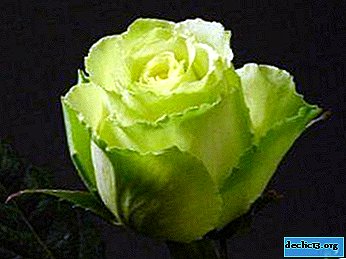If there are midges in the orchid: reasons and what to do in this case?

You have acquired a beautiful orchid, finally waited for its flowering and now you can not stop looking at her. And you seem to care properly, and water on time. But here there are very significant troubles in the form of attacking midges. Where do they come from and where to look for a reason?
How to recognize them, get rid of them at home, as well as how to prevent the further appearance of black and white midges in your flower pot, will be described in this article. You can also watch a useful video on this topic.
The appearance of insects
As they say, the enemy needs to know in person. In our case, adult “enemies” have the appearance of small black mosquitoes, and can also be found in this guise: an elongated shape, a belly in a strip, two wings. The length of the “attackers” usually does not exceed five millimeters.
Signs that the flower is affected by them
Orchid itself looks different depending on the type of attacking midges.. All parts of the plant can be affected. External signs of the presence of midges in a flower can be:
- small brown spots on the leaves;
- white porous coating in the same place;
- black small dots against the whitened part of the leaf plate;
- complete whitening of leaves;
- on the inflorescences themselves, one can clearly see small midges both white and dark;
- in the affected soil, it is also easy to examine small insects.
Types of pests
Attacking insects can be divided into several types. We will talk more about each of them.
Mushroom mosquitoes

Another name is sciarides. The environment for the development of this type of insect is a cool damp room. Most often this happens in spring or autumn. Mushroom mosquitoes fly in swarms, making them easier to spot. Their length varies within four millimeters, the color is black or dark brown, the number of wings is two.
ATTENTION: Mushroom mosquitoes themselves are not particularly dangerous for orchids. But if their larvae can get into the ground, then the likelihood of your beauty’s death will appear and whatever you do, it will not help. This occurs because larvae reaching a centimeter in size contribute to root decay. After this, the plant can no longer be saved.Whiteflies

If you observe a swarm of white midges circling over an orchid, you should know: you have to fight against whiteflies. Despite their miniature size (whiteflies do not grow more than one or two millimeters), they can cause irreparable harm. You can detect the larvae of these midges on the back of the leaves, as well as along the entire length of the stem.
Whiteflies are distinguished by yellow stains on the green surface of the plant. These small pests during the period of their development can destroy up to half of the entire orchid. When a whitefly is affected, the leaves begin to deform, dry and gradually fall away.
Fruit flies

Otherwise, they are called their fruit midges. They have the following appearance: the body is yellow, one pair of wings, and the most important distinguishing feature is red eyes. Drosophila species number about half a million. One grown midge can lay up to four hundred eggs. Twenty-four hours later, larvae form from these eggs, from which midge babies hatch in a week (their size is five millimeters).
Drosophila are always located on the surface of the soil due to heavy watering, as a result, the process of decay of the substrate begins. However, fruit midges are not particularly dangerous.
Thrips

They are characterized by an elongated striped body with wings tightly pressed to the body. They can be found in the ground. But most often they live on leaf plates, the juice of which they feed. About the appearance of thrips, brown pigmentation (reminiscent of prokusi) will tell you, less often - a silver film. Thrips cause the leaves to dry and the whole plant dies.
This type of pest is very difficult to notice in the daytime, as they are in the ground at this time. These midges are much more active at night. Inflorescences and the root system can also be affected by thrips.
IMPORTANT: It is worth noting that thrips can multiply quite quickly, so you need to take measures to destroy them immediately after you notice them. Do not waste your time!In more detail about thrips on an orchid, as well as how to deal with them, we wrote in this article.
Watch a video about thrips pests:
You will learn about other pests that may bother your orchid in a separate article.
Why do insects appear on plants?
The first reason for the reproduction of insects in plants may be the soil mixture itself. Initially, it may already contain pests, which you do not even know about. The danger is that midges can jump from one flowerpot to another, thereby hitting neighboring orchids.
We list a few more factors that contribute to the appearance of midges on the surface of the plant or in the soil itself:
- heavy or irregular watering (it is necessary to allow the soil to stand completely dry for at least two to three days);
- the presence of decorative moss on the surface of the earth (it prevents the soil from breathing);
- fertilizer with folk remedies such as tea leaves, coffee grounds, eggshells;
- moisturizing with water infused with bread or other yeast products.
What to do?
To understand how to remove insects and what you need to process, you need to determine what kind of pest your plant attacked. But there are general rules for killing midges suitable for all types of attackers:
- Place the affected flower in an isolated place for at least a month.
- Wash off all visible midges with warm water. This can be done with a damp cloth or with powerful spraying. This procedure will help get rid of most of the midges.
- Trim all affected areas of the orchid. Do not forget to process the places of cuts with wood ash.
You can process a flower with both folk and pharmacy chemicals. But experienced gardeners recommend resorting to the help of the latter only in very extreme cases. To folk remedies include:
- soap solution (pour one teaspoon of liquid soap 0.2 liters of water);
- garlic tincture (pour five cloves of garlic with boiling water) (they also recommend simply placing a clove of garlic in the ground);
- a solution of olive or grape oil (pour a tablespoon of oil in half a liter of water);
- wood ash, which not only reduces the acidity level of the soil, but also feeds it.
As for insecticides, for each type of attacking insect its own variety of drugs is used:
 With whiteflies it is better to fight with a solution of laundry soap. But if this remedy does not help, use “Actellik”, “Aktar”, “Bazudin”, “Fury” (it is necessary to spray the plant with these means every five days).
With whiteflies it is better to fight with a solution of laundry soap. But if this remedy does not help, use “Actellik”, “Aktar”, “Bazudin”, “Fury” (it is necessary to spray the plant with these means every five days).Also, a vacuum cleaner will help you say goodbye to the main part of adult whiteflies. Frighten off the midges, wait until they begin to fly over the orchid and collect them with a vacuum cleaner.
- In the fight against thrips, Fitoverm or Aktellik will help you. (To process no more than three times with a time interval of ten days). After the destruction of thrips, it will be necessary to cultivate the soil monthly to prevent the re-emergence of these midges.
- Scyarides are easily defeated without even resorting to chemical solutions. It is enough to install the adhesive tape. It is not superfluous, of course, to treat the soil with an insecticide. (“Raptor”, “Dichlorvos”, “Raid”). It will not be superfluous to process the surface on which the flowerpot with an orchid is located.
After applying many aerosol insecticides after a half-hour period, it is necessary to ventilate the room.
- For Drosophila, a hunger strike will be the main blow. This can be achieved by removing all food debris from the house, especially rotten vegetables and fruits.
Always treat not only the plant itself, but also the soil in which it develops.
Remember that only the correct use of funds will help cure an orchid. If you use the drugs not according to the instructions, this will lead to even more infection of the plant or its complete destruction.
Prevention
To avoid wreckers, gardeners should act as follows:
- Observe the watering regime (let the flower stand for 2-3 days with completely dried soil).
- Maintain the optimum moisture level in the room.
- Put a citrus crust or a sprig of lavender next to the flower pot - they scare off the midges.
- Do not store leftover food in the kitchen; throw away garbage bags on time.
- To hold any soil mixture, including that purchased in a store, before planting, keep a couple of days in the cold, for example, in a freezer. This procedure will kill all existing midges.
- Wipe the leaf plates with a damp cloth, and periodically with a soapy solution.
- Put mosquito nets on the window openings in order to avoid flying mosquitoes from the street.
Conclusion
As we have already understood, no living creature, which is our orchid, can not exist without the occurrence of any disease. But, if you respond to pests in a timely manner, you can save your plant. Therefore, do not delay with rescue measures. But this must be done competently and thoroughly. One of the main rules of any treatment is systematic.
Otherwise, your irregular therapeutic measures can be perceived by the flower as another stress, which will significantly worsen the already deplorable state of the orchid. Follow the instructions and our tips, and your pet will continue to attract the admiring glances of your household.

 With whiteflies it is better to fight with a solution of laundry soap. But if this remedy does not help, use “Actellik”, “Aktar”, “Bazudin”, “Fury” (it is necessary to spray the plant with these means every five days).
With whiteflies it is better to fight with a solution of laundry soap. But if this remedy does not help, use “Actellik”, “Aktar”, “Bazudin”, “Fury” (it is necessary to spray the plant with these means every five days).















